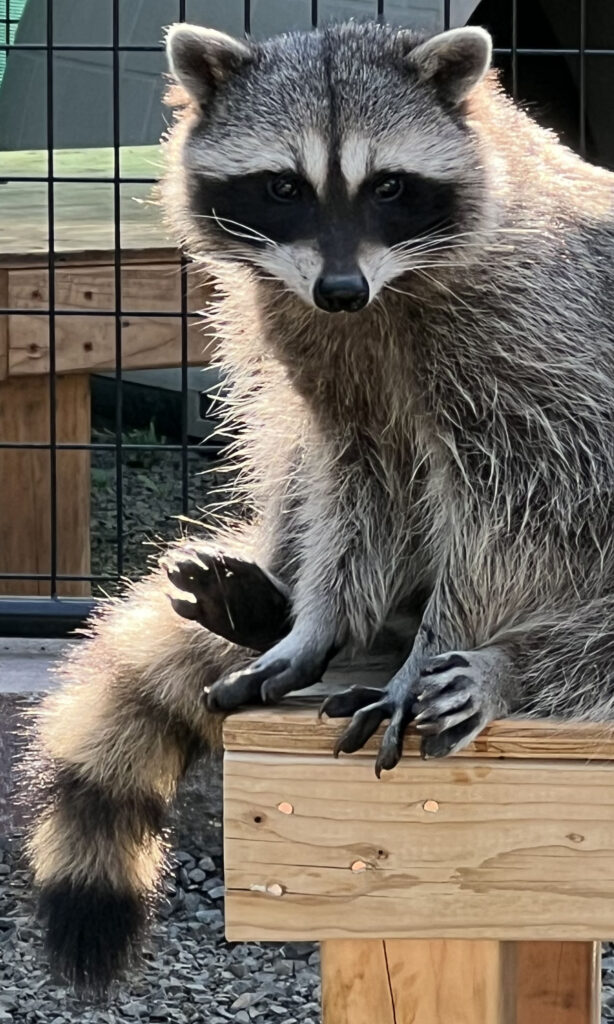Raccoons – Billy Thurman & Milly
(Procyon lotor)
Clever, curious, and endlessly resourceful, raccoons are some of North America’s most adaptable mammals. Known for their dexterous hands, masked faces, and playful personalities, they often spark both admiration and misunderstanding.
At Cat Tales Wildlife Center, our resident raccoons—Billy Thurman and Milly—serve as important ambassadors for wildlife coexistence. Their stories remind us that even well-meaning human intervention can have unintended consequences, and that wild animals, once habituated, can rarely return to the wild.
The Trouble with “Helping” Wildlife
Every spring, well-intentioned people find baby raccoons and assume they’re orphaned. But many times, the mother is simply out foraging. Without realizing it, rescuers can turn wild kits into habituated animals—those who associate humans with food or safety.
Unfortunately, such animals cannot be released safely and are often euthanized. Sanctuaries like Cat Tales offer one of the few alternatives, giving these animals a permanent, educational home where they can thrive safely while teaching others about responsible wildlife interaction.
- Distinctive Look: Stocky and short-legged, raccoons are easily recognized by their black “mask,” ringed tails, and dexterous hands.
- Incredible Adaptability: Found everywhere from forests and wetlands to cities, raccoons thrive near humans by using their intelligence to find food and shelter.
- Diet: Omnivorous and opportunistic—fruits, insects, small animals, and even leftovers make up their varied diet.
- Behavior: Primarily nocturnal, raccoons are curious problem-solvers known for “washing” their food—a behavior linked more to tactile exploration than hygiene.
- Skills: They are excellent climbers and swimmers, with nimble hands that allow them to open latches, containers, and even doors.
- Lifespan: In the wild, they live 3–4 years; in protected environments, up to 20 years.
- Myth: Raccoons are aggressive.
Reality: They are defensive when threatened but not naturally aggressive toward humans. - Myth: All raccoons carry rabies.
Reality: Only a small percentage are infected; most are healthy, and risk is low with proper precautions. - Myth: Raccoons are dirty animals.
Reality: They are surprisingly clean and often “wash” food before eating. - Myth: Raccoons make good pets.
Reality: Keeping raccoons as pets is illegal in most states and unsafe for both people and the animal.
Their Journey to Cat Tales
Billy Thurman – The Lucky Survivor
Born June 1, 2023, Billy Thurman’s story began when a well-meaning family found him orphaned and decided to care for him themselves. Despite their kindness, Billy became habituated to human contact, which made him unsuitable for release.
When allowed outside one day, Billy followed his instincts toward water and was attacked by an unknown animal, suffering deep puncture wounds. The family contacted a veterinarian, who notified the Washington Department of Fish and Wildlife (WDFW)—and fortunately, Cat Tales was also called.
With permission from WDFW, Billy was transferred to Cat Tales in May 2024, where he received immediate veterinary care from Dr. Luther McConnell at Animal Clinic Spokane. His injuries were treated, he was vaccinated, and neutered. Billy made a full recovery and now thrives as a curious, social raccoon—always ready to explore enrichment puzzles or use his hands to search for treats hidden in the water.
His story teaches compassion and the importance of calling licensed wildlife rehabilitators before intervening with wild animals.


Milly – The Cautionary Tale
Milly’s journey is a reminder that not all good intentions lead to good outcomes. As a young kit in 2023, she was taken in by a couple who believed she was orphaned. Instead of contacting a wildlife rehabilitator, they decided to raise her as a pet.
When Milly grew into a full-sized raccoon with all her natural instincts—curiosity, climbing, and mischief—her behavior became unmanageable. Eventually, the couple reached out to professionals for help, and through Washington State University’s Veterinary Teaching Hospital, she found her way to Cat Tales.
Dr. Marcie Logsdon, WSU veterinarian, reminds the public that keeping raccoons as pets is illegal and unsafe, urging people to contact wildlife experts before attempting to help. Milly was one of the fortunate few to find sanctuary placement and now lives a full life as an educational ambassador—playful, clever, and endlessly curious.
Conservation & Coexistence
Raccoons are a testament to adaptability—but that success sometimes brings them into conflict with humans. Urban raccoons raid trash cans and outsmart “raccoon-proof” containers, leading to frustration for homeowners. Yet, these behaviors are simply survival instincts at work.
At Cat Tales, Billy and Milly help teach that coexistence means simple actions: securing garbage, feeding pets indoors, and giving wild animals space. Respect, not removal, ensures harmony between humans and nature.
Life at Cat Tales
Our raccoons live in custom habitats designed to encourage natural behaviors like climbing, foraging, and washing food in water pans.
- Enrichment: Puzzle feeders, floating treats, and scent trails keep their intelligent minds engaged.
- Observation & Care: Keepers track each raccoon’s diet, weight, and health daily, ensuring their well-being.
- Ambassador Role: Visitors often laugh watching their busy paws at work—proof that curiosity and play are at the heart of raccoon life.
How Billy & Milly Inspire
Their stories teach visitors about the consequences of wildlife habituation and the importance of contacting professionals before “rescuing” wild animals.
They represent the need for stronger public awareness of wildlife laws and ethical care standards.
Behavioral observations of enrichment use and social adaptation contribute to ongoing efforts in improving raccoon welfare in managed care settings.


